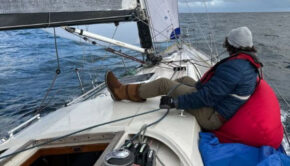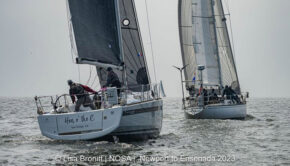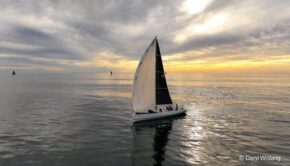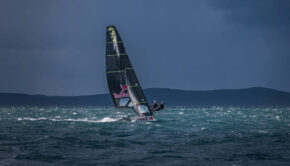Peter Isler: Lessons from a Record Run
Published on May 2nd, 2022
World renowned sailor, educator, and 2-times America’s Cup winning navigator Peter Isler is offering a Scuttlebutt discount on his online curriculum of weather and navigation courses. But first he shares a recent experience:
I had the good fortune of getting the invite to navigate Manouch Moyashedi’s Rio100 in the 2022 Newport to Ensenada Race, a 125 nm course from Newport Beach to the finish in Ensenada, Mexico. With the start on April 22, the race has been an important fixture in the west coast offshore sailing scene for 75 years.
I’d sailed on Rio100 when it was first launched (after its transformation to a supermaxi) and did the 2014 Sydney Hobart Race on it, though for the last couple of years, I’ve been racing against it on Roy Disney’s turbo’d Volvo 70 Pyewacket70. But with Pyewacket not doing the race, I was all in.
I’d been watching the weather set up and it looked like the “100 year race” – a front was forecast to pass through in the morning hours and fresh northwest fill would follow to push the fleet south quickly. Thankfully, the forecast stayed true to form.
At race start at high noon we rolled out the 100 footer’s massive A3 reaching sail and headed off down the race track – soon hitting 20 knots on the hot VMG angle. The wind stayed perfect the rest of the race and when we crossed the line at 7:02pm, we had shaved over 2 ½ hours off the monohull race record.
That one could stand for a very long time, as could the multihull course record that we set on Tom Siebel’s MOD70 Orion in 2016 of 5 hours and 17 minutes.
For a race that most southern California racers think of as being one of those sleep depriving “sprints” with a finish after dawn as you slat across the finish line with the drifter barely drawing, it definitely felt weird (and fun) to finish before sunset.
But every race is different, and woe be to the tactician that just follows the golden rules that worked (supposedly) in previous race. Even on the remarkably direct track that we took on Rio (a powerboat would have followed our route for 90% of the race), there were some great take aways to remember:
1. Use Weather Routing and Weather Models as a guide and not as an absolute.
My partner in Marine Weather University, Chris Bedford keeps hammering that point home, but it’s hard when that beautiful latest weather model shows such a particular track to take. Off the starting line, most of our fleet failed to heed that advice and set smaller reaching sails to take a slightly higher (and slower) course than rhumb line to get offshore (where the models said there was more wind).
I resisted the temptation and used the good old general rules that I learned from Dennis Conner years ago: When reaching toward a faraway waypoint – maximize your VMC (Velocity Made good on Course) and when in doubt – sail the direct course.
2. Sail the shortest course and remember the Cosine Rule.
On Rio100 we put up the “big gear” and had a reef in the main and were pushed slightly low of course….. but I was happy – our speed was faster than sailing rhumb line and we were getting closer to the finish line (than if we put up smaller sails and headed on course).
DC loved to talk about the Cosine Rule – which is basically that middle school math that tells us as long as we are within 15 degrees of course – we are barely sailing any extra distance – so if you can go faster by footing off (or heading up) then go for it. The cosine of 15 degrees is 0.966 So if you can go 5% faster by sailing 15 degrees off the rhumb line to a faraway destination– it’s a “gainer”.
3. Keep sail changes simple.
Changing reaching headsails on any boat is a costly maneuver. On the 100-footer – even with two furling headsails – it would entail bearing away to make working on the bow possible – and probably 10 minutes of crew off the rail messing about with setting up.
As we neared San Diego’s Point Loma – we were still low of course and slowly getting lifted. With 30 minutes to go – it looked like we would have to change sails to clear the point – but then the course would open up to leeward – so it would be a short term change – never good on a maxi (or any boat).
But we expected a slow lift so we might just make it – and we didn’t want to change too soon. As we discussed how many minutes we needed to make the change (to avoid sailing onto the beach in San Diego – I hate lee shores), I remembered a lesson that the pro Volvo sailors that I’ve sailed with on Pyewacket70, Rambler100, and other high speed maxis had taught me. For squalls and short term course changes, “roll it up and sail with the jib”.
We already had the J4 up under the massive A3 – so we could safely push things right up to the last minute, with all the crew still hiking – and then if we needed to head up to clear the point – we could simply furl the A3 (good old roller furlers) and sail for a few minutes with the jib – once we cleared the point – we could redeploy the A3 with a minimum of harangue.
Even on a smaller boat, this is valid lesson. A jib is infinitely easier to change to than another reaching headsail – so for a short term course change or a short squall – keep things simple and go for the easy change.
4. Watch the sky.
Off the starting line we spotted a high thin cloud in the shape of a line ahead of us on the rhumb line.. it was pointing directly downwind. As I’ve learned from Chris’ classes in Marine Weather University – you can glean a lot from looking up – not down at your weather app.
I told the crew that looked like a convergence cloud – where the wind would lift as we approached it – and then head us as we passed to the other side.
Sure enough – that’s exactly what happened – and had I looked at the satellite image I could have known where we would cross this transition line – instead I just kept hiking and praying nothing would break because we were sailing straight at the finish on a record pace!
————
Hey, speaking of Marine Weather University – which is part of my online school: Peter Isler’s Academy of Sailing Secrets. We are having a May/Mother’s Day sale on campus. Please have a browse around our curriculum which features Chris Bedford’s immensely valuable weather classes and full-length courses and my classes on race prep, navigation and Expedition software. For our Scuttlebutt family and friends, here’s 15% off coupon code that is good until May 9: ITSMAY









 We’ll keep your information safe.
We’ll keep your information safe.